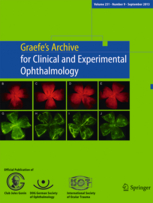Gli autori hanno valutato l’efficacia di un farmaco immunosoppressore nel trattamento topico degli infiltrati conseguenti a cheratite da adenovirus. Questa condizione arreca notevoli fastidi e riduzione visiva dopo un episodio di cheratociongiuntivite epidemica, patologia relativamente frequente.
Il tacrolimus è un recente immunosoppressore che ha oggi largo impiego nella prevenzione del rigetto dopo trapianto di organo e viene impiegato in forma di collirio in alcuni casi di trapianto di cornea.
Il suo uso nella patologia in oggetto risulta, da questo studio, efficace e ben tollerato, aprendo nuove strade nell’approccio a questa patologia, solitamente trattata con lunghe terapie a base di cortisone.

Topical 0.03 % tacrolimus for subepithelial infiltrates secondary to adenoviral keratoconjunctivitis
Levinger E, Trivizki O, Shachar Y, Levinger S, Verssano D.
Graefe’s Archive for Clinical and Experimental Ophthalmology
April 2014
Objective To determine the safety and efficacy of topical 0.03 % tacrolimus ointment treatment for subepithelial corneal infiltrates (SEIs).
Methods This prospective non-controlled interventional case series included patients with SEIs who had been previously treated with topical corticosteroids with either no improvement or the medication being withdrawn due to associated intraocular pressure (IOP) elevation. The patients were treated with 0.03 % tacrolimus ointment twice daily for 22 weeks (including a 1-month washout). The objective data were best-corrected Snellen visual acuity (BCVA), IOP, and full ocular examination results, including SEI severity and the Schirmer test. The subjective data were the patients’ responses to a questionnaire at all follow-up visits.
Results The patients consisted of five males (45 %) and six females (55 %) (mean age 50 ± 11 years) who were followed up for an average of 22 weeks. The mean BCVA (logarithm of the minimum angle of resolution [logMAR]) before and after treatment was 0.34 ± 0.09 and 0.08 ± 0.04 respectively (p = 0.042). All the patients evidenced significant objective clinical improvement, and none had a severe degree of SEI at the end of the treatment. The patients reported considerable reduction in the severity of their symptoms (foreign body sensation, glare, etc.). Three patients were excluded due to side-effects (one had severe dizziness and discomfort), and their data were excluded from the study.
Conclusion Topical tacrolimus 0.03 % is a safe and effective alternative treatment in patients with SEIs who do not respond to other treatment modalities or have untoward side-effects from topical steroids.
